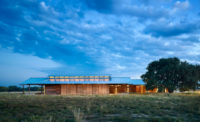| Photo © John Linden |
| Cherokee Studios, Los Angeles, CA |
The American Institute of Architects Committee on the Environment (AIA-COTE) has announced its Top Ten Green Projects for 2011. “The bar has been raised” since the Top Ten competition began, noted members of the jury. “Now we want to see diverse project types, projects that resolve urban issues or social issues, projects that change occupant behavior.”
The jurors also noted particular interest in innovative water management techniques, passive survivability, urban infill, and community improvement. “The architect is in a way taking on the role of a developer, and they are changing city policy about what is acceptable,” concludes juror Joshua Aidlin, AIA. Other members of the Top Ten jury for 2011 were: Mary Guzowski; Kevin Kampschroer; Mary Ann Lazarus, FAIA; Jennifer Sanguinetti, P.E.; and Lauren Yarmuth.
Profiles of these projects are available by clicking each project name below (full profiles available by subscription), or at www.aiatopten.org.
Cherokee Studios, Los Angeles
BROOKS + SCARPA (formerly Pugh + Scarpa)
A mixed-use urban infill project, this building features a green roof and provides stormwater filtration to help prevent ocean pollution. A system of perforated screens allows daylight and outdoor air to permeate the apartments while also providing shade as residents desire.
First Unitarian Society Meeting House, Madison, WI
The Kubala Washatko Architects
This addition to a historic meetinghouse designed by Frank Lloyd Wright takes the form of an arc to counterbalance the triangles of the original structure. Stormwater runoff from the original meetinghouse has been flooding neighboring properties for years, but the green roof and pervious landscaping of the addition have solved this longstanding problem.
Greensburg Schools, Greensburg, KS
BNIM Architects
After a tornado destroyed almost every structure in Greensburg the community chose to rebuild using sustainable strategies. For the schools, that meant a major emphasis on daylighting and indoor air quality to improve the learning environment. The project also features stormwater capture and reuse, along with a constructed wetland for onsite wastewater treatment.
High Tech High, Chula Vista, CA
Studio E Architects
Students at this high school learn by doing—both indoors and out. The design of the school supports its educational philosophy and methodology by allowing easy access between interior and exterior and integrating built and natural environments. The site features bioswales and rainwater catchment and reuse along with natural ventilation, ample daylight, and a photovoltaic array.
Livestrong Foundation, Austin, TX
Lake|Flato Architects
This adaptive reuse of an old warehouse in a working-class area of Austin centers around a wide-open floor plan while also providing small, flexible work spaces built of salvaged wood. The building aims to revitalize the area while maintaining community connectedness and a sense of place.
LOTT Clean Water Alliance, Olympia, WA
The Miller | Hull Partnership
The large water feature that greets visitors to this project is not just pretty: it is essential to the educational function of the building, which teaches local residents about water treatment and reuse. In addition to onsite wastewater treatment, the project also features green roofs, wetland habitat, and native vegetation.
NREL Research Support Facility, Golden, CO
RNL Design
The largest building in the country targeting net-zero energy, this facility at the National Renewable Energy Laboratory makes its own energy with onsite photovoltaics and uses a transpired solar collector to heat ventilation air. Rain gardens, permeable pavement, and bioswales work with the natural terrain to help manage rainwater runoff.
OS House, Racine, WI
Johnsen Schmaling Architects
This single-family home fills in a vacant urban lot within walking distance of shopping, recreation, and public transportation. Photovoltaics and solar water heat provide the bulk of the family’s relatively modest energy needs, and a variety of stormwater management strategies were crucial to the project, since it sits on a bluff just above Lake Michigan.
Step Up on 5th, Santa Monica, CA
BROOKS + SCARPA (formerly Pugh + Scarpa)
Affordable, mixed-use apartment buildings do not usually focus on sustainable strategies, but the designers of this project set out to show it could be done. Using daylighting, strategic light filtration, and cross-ventilation, these 46 studio apartments provide energy- and water-efficient housing and support services for homeless and mentally disabled people in Santa Monica.
Vancouver Convention Centre West, Vancouver, British Columbia
LMN Architects (Design Architect), DA/MCM (Prime Architect)
A six-acre green roof is the centerpiece of this massive waterfront project, which also includes a constructed reef, onsite wastewater treatment, and a seawater-based heat pump system. Built on a remediated brownfield, the center provides habitat for wildlife and outdoor gathering spaces for people.
Disclosure: BuildingGreen, Inc. provides editorial and technical services for the online submissions and presentation of the AIA-COTE Top Ten.
Copyright 2011 by BuildingGreen Inc.













Post a comment to this article
Report Abusive Comment